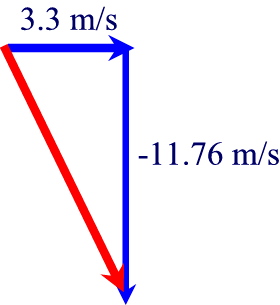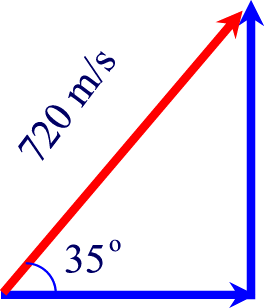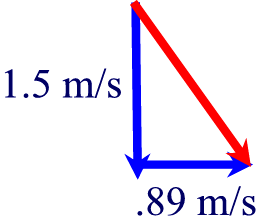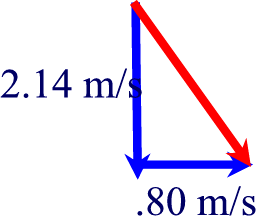2 Dimensional Motion: | 1 | 2 |
3 | 4 | 5 | 6 |
7 | 8 | 9
| 10 | 11 | 12 | Go up
- by Eric Hess, 2002
1. Fred leaves the edge of a 12m tall cliff with a
horizontal velocity of 4.8 m/s. What time is he in the air? How far from the
base of the cliff does he land? What is his velocity upon impact with the water
in terms of x and y components?
Here's what you know,
| Horizontal |
Vertical |
Dx = ?
vi = 4.8 m/s
vf = 4.8 m/s
a = 0
Dt = ?
Now we need to find Dx. We know Dt,
since time is on both sides. We can use vavg = Dx/Dt,
solving for Dx.
Dx = vavg(Dt)
= 4.8(1.565) = 7.5 m. So Fred landed 7.5 meters from the base of the
cliff.
Now we're asked to find the horizontal and vertical components.
Luckily, we've already found them. They told us that the horizontal
velocity = 4.8 m/s, and we calculated the vertical to be -15.3 m/s, so
the answer is 4.8 m/s x - 15.3 m/s y. |
Dx = 12 m
vi = 0 m/s
vf = ?
a = -9.8 m/s/s
Dt = ?
Solve for vf
vf2 = vi2 + 2a(Dx)
= 0 + 2(-9.8)(12)
vf2 = -235.2; vf =
-15.336 m/s
Now solve for Dt using vf = vi + a(Dt)
-15.336 = 0 + (-9.8)(Dt) = -15.336/-9.8
= 1.565 sec. So Fred was in the air for 1.56 seconds.
|
(Table of contents)
2. Rachel leaps from the edge of a cliff
with a velocity of 3.3 m/s horizontally. She
hits the water 1.2 seconds later. How
far out does she land? What is her speed when she hits?
How high is the cliff?
Here's what you know
| Horizontal |
Vertical |
Dx = ?
vi = 3.3 m/s
vf = 3.3 m/s
a = 0
Dt = 1.2 sec
We can use the formula vavg = Dx/Dt
to find the distance.
Dx = vavg(Dt)
= 3.3(1.2) = 3.96 m.
|
Dx = ?
vi = 0 m/s
vf = ?
a = -9.8 m/s/s
Dt = 1.2 sec
We know the horizontal velocity, now we need to find the vertical
velocity. We can use vf = vi + a(Dt).
vf = 0 + (-9.8)(1.2) = -11.76 m/s.
So our vector map looks like this:

And since speed is the hypotenuse, it equals:
3.3 m/s2 + (-11.76)2 = c2, so c =
12.2 m/s
Finally, we need to find Dx, the height.
Dx = 1/2(vi + vf)Dt
= 1/2(0 + 11.76)1.2 = 7.1 m
|
(Table of contents)
3. A
golf ball leaves the ground with an initial vertical velocity of 53 m/s and a
horizontal velocity of 42 m/s.
a) Draw the initial velocity vector.
Find the initial speed. b) For what time is the ball in the air?
c) How far does it go in this time?
First, we are asked to draw the
vector:
And now, we're supposed to find
the speed. And speed is the hypotenuse. Since 42 m/s2 +
532 = c2, c = 67.6 m/s
Now, we need to set up a table to find the time,
and horizontal distance:
| Horizontal |
Vertical |
Dx = ?
vi = 42
vf = 42
a = 0
Dt = ?
As the Stones put it, "Time is on both sides," so we know
time = 10.8 horizontally also. Now we can use
vavg = Dx/Dt
to find out the distance.
Dx = vavg(Dt)
= 42(10.8) = 453.6 m = 454 m |
Dx = ?
vi = 53 m/s
vf = -53 (what goes up, must come down)
a = -9.8 m/s/s
Dt = ?
First, we need to find the time. We can use
vf = vi + a(Dt),
-53 = 53 + (-9.8)Dt
Dt = -106/-9.8 = 10.8 seconds
|
(Table of contents)
4. A
rifle is fired at an angle 35o
above the horizontal at a speed of 720 m/s.
a) Draw a picture of the initial velocity vector.
b) What is the horizontal velocity?
c) What is the initial vertical velocity component? d) What time will the
shell be in the air?
e) What distance will it go in that time?
First, lets draw the vector:

Now, they want us to find the horizontal velocity, which we can find using
the cosine of the 35o angle.
cos(35) = x/720, x = cos(35)720 = 589.79 = 590 m/s
horizontal velocity
Now, to find the vertical velocity, we can use the sine of the angle
sin(35) = x/720, x = sin(35)720 = 412.98 = 413 m/s
vertical velocity
Now we can use our table:
| Horizontal |
Vertical |
Dx = ?
vi = 590
vf = 590
a = 0
Dt = ?
And since time is on both sides, we can use Dx
= vavg(Dt) to find the distance.
Dx = 590(84.3) = 49,729 = 49,700 m that
the bullet travelled. |
Dx = ?
vi = 412
vf = -412
a = -9.8 m/s/s
Dt = ?
To find time, we use:
vf = vi + a(Dt),
-413 = 413 + -9.8(Dt)
Dt = -826/-9.8 = 84.3 seconds
|
(Table of contents)
5. A
river has a current of 1.5 m/s, and a swimmer has a velocity of .89 m/s.
If they head straight across the river, what will be their speed
(hypotenuse) with respect to the shore? If
the river is 45 m wide, how much time will it take them to cross? How far downstream will they drift in that time?
First, lets draw the vector:

The speed would be the hypotenuse, or 1.52 + .892 = c2,
so c = 1.74 m/s.
So, our table looks like:
| Horizontal |
Vertical |
Dx = 45 m
vavg = .89 m/s
Dt = ?
To find time, we can use vavg = Dx/Dt:
Dt = Dx/vavg
= 45/.89 = 50.56 m/s or 50.6 m/s
|
Dx = ?
vavg = 1.5 m/s
Dt = ?
The distance downstream that they'll drift is just the vertical
distance. Time is on both sides, so again we can use vavg = Dx/Dt:
Dx = vavg(Dt)
= 1.5(50.56) = 75.8 m
|
(Table of contents)
6. A
canoe heads straight across a river with a current of .80 m/s.
It takes the canoe 35 seconds to cross the 75 m wide river.
What is the speed of the canoe with respect to the water?
How far does the canoe drift downstream?
What is the speed of the canoe with respect to the shore?
This is just like the last problem, but backwards. We need
to fill in the table to draw the vector.
| Horizontal |
Vertical |
Dx = 75 m
vavg = ?
Dt = 35 seconds
First, they ask for the speed (velocity) of the canoe. Just use:
vavg = Dx/Dt:
= 75/35 = 2.14 m/s
|
Dx = ?
vavg = .80 m/s
Dt = 35 seconds
Then it asks for the vertical
distance.
Use vavg = Dx/Dt:
Dx = vavg(Dt)
= .80(35) = 28 m
|
Now we have all the information to draw the velocity vector:

c2 = 2.14292 + .802, c2
= 2.29 m/s
(Table of contents)
7. Use
the range and angle equations for this part:
Angle
= 67o, Speed = 420 m/s, Range = ?
Here we can just use the equation for range.
range = (v2/g)sin(2q)
range = (4202/9.8)sin(2
x 67o)
= 12,948 m
(Table of contents)
8. Angle = 12o,
Speed = 45 m/s, Range = ?
Again, just use the range equation
range = (v2/g)sin(2q)
range = (452/9.8)sin(2
x 12o)
= 84 m
(Table of contents)
9. Angle = 82o,
Speed = 24 m/s, Range = ?
Again,
just use the range equation
range = (v2/g)sin(2q)
range = (242/9.8)sin(2
x 82o)
= 16.2 m
(Table of contents)
10. Speed = 34 m/s, Range = 62 m, Angle = ?
Use the range equation, solving for the angle
q
= (sin-1(g(range))/v2)/2
q
= (sin-1(9.8(62))/342)/2 = 15.9o
(Table of contents)
11. Speed = 12 m/s, Range = 11 m, Angle = ?
Solving for the angle,
q
= (sin-1(g(range))/v2)/2
q
= (sin-1(9.8(11))/122)/2 = 24.2o
(Table of contents)
12. Speed = 24 m/s, Range = 62 m, Angle = ?
Solving for the angle,
q
= (sin-1(g(range))/v2)/2
q
= (sin-1(9.8(62))/242)/2 = Can't take the
sin of a number greater than 1, so the problem is impossible
(Table of contents)



